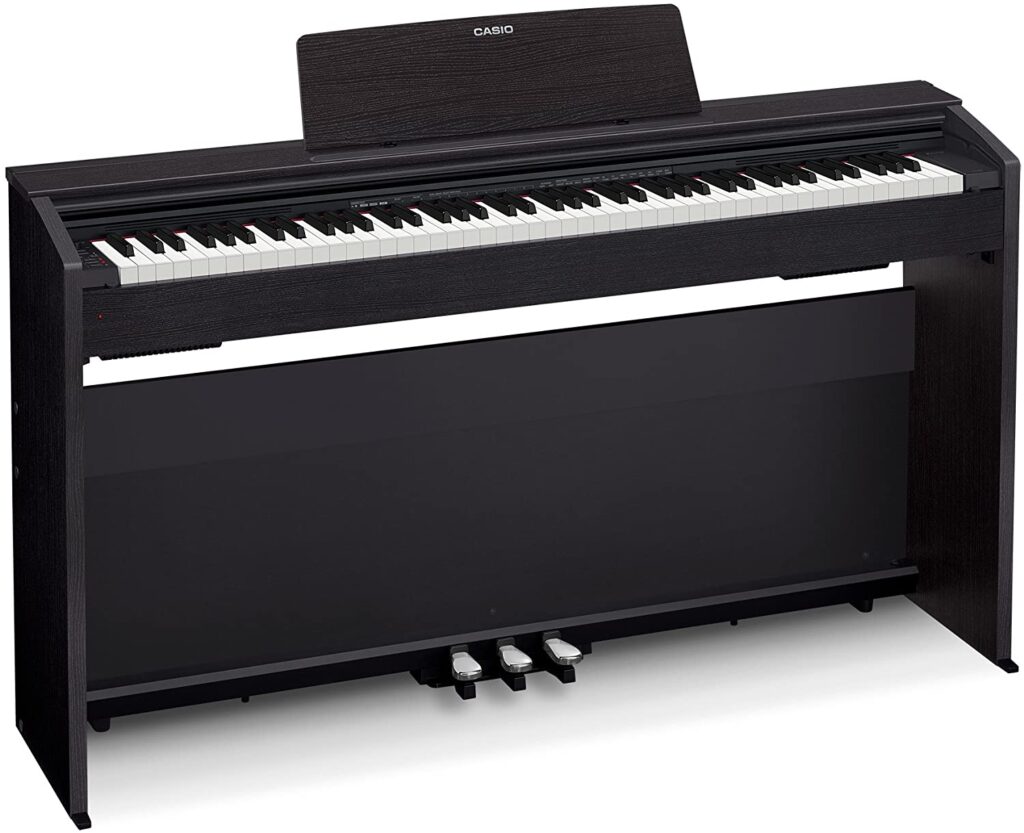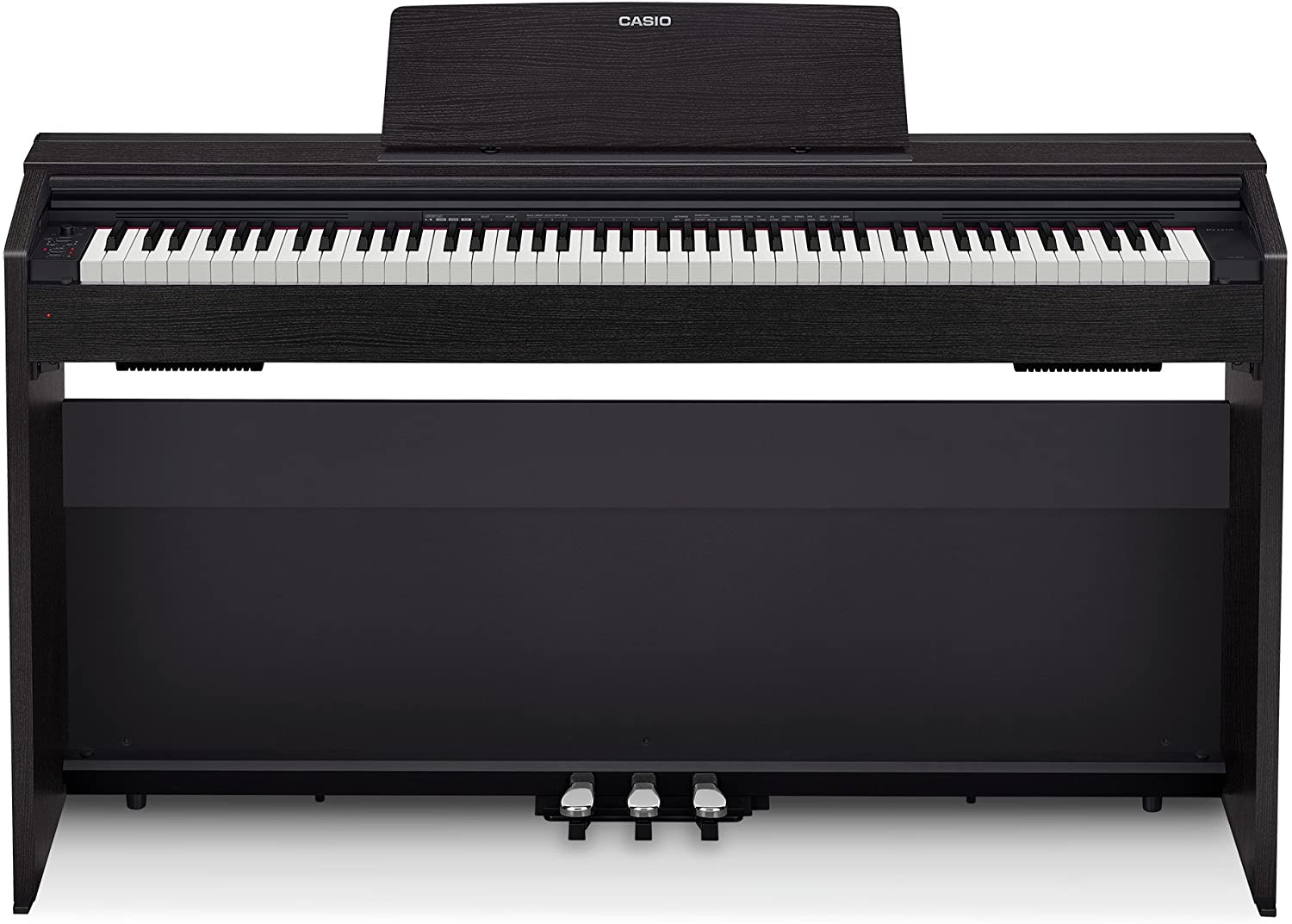Replacing its predecessor, the PX-860, the Casio PX-870 digital piano had plenty of hype when it was released. The former had been a successful flagship for many years, meaning that a lot was expected from its replacement.
And when Casio announced the new flagship of the Privia model, they understood the weight of their statement. But did the PX-870 live up to its hype?
This Casio PX-870 review looks at that question in-depth to inform you all you need to know about Casio’s new Privia flagship. But before diving into the review, let’s have a look at this product’s highlights.
Product Overview
Like many Casio digital pianos, the PX-870 features a modern cabinet design. It also has a hammer action keyboard featured with Ebony and Ivory key simulation. The keyboard is backed up with 3 piano-style pedals, which will be discussed later in the review.
To the sound, Casio applied their new Morphing AiR sound engine in the PX-870. This sound source is responsible for detailed expressions, enabling the PX-870 to produce vibrant and resonating tones profoundly.
As you’d expect, this new flagship bears multiple improvements from its predecessor, including a unique 4-layer piano sound. Other enhancements include a new sound projection system and other significant enhancements discussed better in the review.
Features of the Casio PX-870 Digital Piano
The features of any digital piano are among the most important factors when purchasing this work of art. You have to understand what you need and if the piano in question can meet your requirements.
Here, we look at the PX-870’s features, including its design, sound quality, keyboard, and connectivity options, among other significant features. With such information, you’ll know what the PX-870 is capable of, and if it’s worth your purchase.
Specifications
- Keyboard – Tri-sensor Scaled Hammer Action Keyboard II with Simulated Ivory and Ebony keytops
- 3 touch sensitivity levels, including Off simulation
- Sound Engine – Morphing AiR Sound Source
- 256 Polyphony notes
- 19 Built-in sounds
- Split and Layer modes
- Sound Effects – Chorus, Brilliance, DSP, and Hall Simulator
- 70 Built-in Songs expandable to a maximum of 10 Songs (at approx. 90KB/Song)
- Lesson Function
- Metronome, Transpose, and Tuning
- 3 Pedals – Damper, Sostenuto, and Soft
- Connectivity – USB type A and B, Phones x 2
- Weight – 34.3kg without the music stand
- Dimensions – (W x D x H) 54.8” x 11.7” x 31.5” w/o the music stand
Casio Privia PX-870 Digital Piano Design

The PX-870 features a compact and stylish design but isn’t a portable digital piano. It has a furniture-style cabinet that blends aesthetically with any décor. Whether in a small apartment, concert hall, or a dome, the PX-870 can fit in the tightest spaces. Therefore, you don’t require a large home to own this instrument, since its dimensions are nearly standard.
As an improvement from the PX-860, this new flagship’s cabinet is more seamless and a bit shorter. Besides that, the PX-870 features a newly developed 4-speaker sound projection system. The speakers project sounds downward and upward, similar to a grand piano.
Hence, the sound released when playing this piano are deep, and the listening sensation more natural. Additionally, the PX-870 also comes with 3-pedal functionality, including the damper, soft, and sostenuto. The damper pedal supports half-pedal functionality, meaning it functions exactly like the damper pedal present in acoustic pianos.
Casio featured the PX-870 with a pull-out keyboard cover to prevent dust or dirt percolation on the keys when the piano isn’t in use. Casio made new enhancements on the control interface and positioned the control buttons to the left of the PX-870, unlike its predecessor.
ALSO READ: Kawai ES8 Digital Piano Review

There are 8 buttons dedicated to the piano’s main sounds and functions, while the additional settings, features, and sounds can be accessed by a combination of keys and the Function button. One con about the interface is that it lacks a display, meaning you’ll have to rely on beep sounds to ascertain the selected setting.
Keyboard

The PX-870 has a natural playing feel that goes close to that of a Grand piano. It features a Tri-Sensor Scaled Hammer Action Keyboard II incorporated with the Grand piano’s specific sound timing.
This is because the difference between Grand and digital pianos’ sound structure is the difference in timing i.e., from when a key is played until it’s fully audible. Hence, this keyboard action integrates a system with 3-sensors capable of detecting each key-stroke sequentially in all the 88 keys available. Additionally, these sensors allow continuous sound production, even if a key hasn’t returned to its original position. This improves playability whenever a key is struck repeatedly.
Like in grand pianos, the PX-870’s keyboard action relies on the hammer’s weight, which provides a smooth touch and a definite playing response. With the graded hammer action, the lower-end keys feel more substantial than those in the high-end, which feel lighter like in acoustic pianos.
For enhanced authenticity, the PX-870 features 3 touch-sensitivity levels, including:
- Soft – With this selection, the sound will change depending on the intensity of a key-stroke.
- Medium – This one gives out the most natural feel and sound regardless of how hard or soft you press the keys.
- Hard – Here, you get a broader dynamic range, and you’ll need to hit the keys loud if you want the loudest noise produced.
Similarly, this piano also allows you to turn off the touch-sensitivity feature if you want the volume to stay the same. Finally, you’ll enjoy a synthetic Ebony and Ivory feel with the PX-870’s keys that arrest moisture and allow you to play comfortably for prolonged hours.
Sound Quality
Sound is another area where the Casio PX-870 excels profoundly. It features the brand’s Multi-dimensional Morphing AiR Sound Engine that provides grade-quality piano sounds, sampled from Casio’s 9’ grand piano. Because this model is an upgrade, it also features an increased memory capacity and a lossless audio compression feature.
The large memory capacity promotes the production of deep sounds with immense accuracy. Moreover, Casio incorporated the PX-870 with a new 4-layer piano sound that further enhances this piano’s sound capabilities. The unique 4-layer is responsible for producing smooth and vibrant sounds accompanied by natural decay.
Below is the division of the PX-870’s 19 built-in piano sounds:
- 5 Grand Pianos
- 4 Organs
- 2 Strings
- Vibraphone
- 4 Electric Pianos
- Bass (lower)
- Harpsichord
To back up these sounds, the PX-870 hosts a polyphony maximum of 256 notes that can withstand any complex music piece. No matter how fast you play on this piano, the polyphony count ensures that it won’t lose any notes.
Connectivity
Phones (Stereo Jacks) – The PX-870 feature 2 x ¼” stereo jacks for Headphones, but can also be used as alternative Line Outs since this piano doesn’t have the Line Out jacks.
USB to Host – You can use the USB Type B cable to connect the PX-870 to a computer and exchange MIDI data. Similarly, you can also use this port to transfer songs and music files between the piano and your PC.
Flash Drive Port – With this USB Type-A port, you can connect a USB flash drive on the PX-870 and quickly exchange files. Additionally, this port allows you to playback both MIDI and WAV files directly from the USB flash drive. Lastly, the port also allows you to save your compositions on a flash drive, enhancing portability.
Casio PX-870 Price
The Casio PX-870 costs slightly more than $1,000 which is a fair price considering the features and benefits that it has to offer. Portability is also another significant benefit that this piano offers, which makes it suitable not only for beginners, but also intermediate and advanced pianists.
Extra Features of the Casio PX-870 Digital Piano
Lid Simulator
In grand pianos, the sound volume and quality change when the lid is raised or lowered. The PX-870 has the same feature used to simulate the sound effects of closing and opening the lid. Hence, the results experienced on the PX-870 are simulations of acoustic effects and occur in exquisite detail.
String Resonance
Most digital pianos virtually reproduce the string resonance effect with strings, which doesn’t result in detailed authenticity. But the PX-870 incorporates the Multi-dimensional AiR Source by Casio and adopts a string resonance system with stereo resonance simulation for all the 88 keys.
Unlike in most digital pianos, the 88 keys’ resonance is wholly and naturally reproduced in the Casio PX-870 digital piano.
Key-Off Simulator
With this feature, the PX-870 reproduces tonal variations resulting from essential release naturally. As a result, you experience realistic reverberations similar to those in grand pianos.
Hall Simulator
The PX-870 features a Hall Simulator that produces differing characteristics of acoustic pianos in profound concert halls.
Concert Play
Here, Casio added 10 high-quality audio data recordings from live orchestra performances. They are responsive and authentic enough to play along with, making the whole experience quite enjoyable.
Headphone Mode
Unlike other ordinary digital pianos, this feature creates an inclusive sonic image once you wear the headphones while using the Casio PX-870. It enhances your playability, taking you closer to the sound field of an acoustic piano.
Volume Sync EQ
This feature allows you to balance low volume sound by adjusting its quality in both low and high registers. And regardless of the volume level, the Volume Sync EQ improves the PX-870’s playability.
Benefits of Owning the Casio PX-870 Digital Piano
Authentic Keyboard – The PX-870 gives you one of the best and most realistic keyboard actions currently on the market. The Hammer Action Keyboard II offers authentic playability, and the Ebony and Ivory synthetic simulation mimic the natural feel of playing on an acoustic piano.
New 4-layer Piano Tone – With this new feature, the PX-870 produces rich tonal variations to give you the most fulfilling aspect of natural decay.
Casio’s Proprietary AiR Sound Source – This newly-developed sound engine by Casio produces high-quality piano sounds sampled from the brand’s 9-foot concert grand pianos.
Improved Sound Projection System – As an advancement from its predecessor, the Casio PX-870 comes with an improved 40W sound projection system that expresses its sounds dynamically.
Reasons You Should Buy the Casio PX-870 Digital Piano
The most obvious reason to buy the Casio PX-870 digital piano is that it’s an improvement from the previous Privia flagship. Hence, it bears multiple advancements, especially on the sound capabilities.
Besides that, the PX-870 has unmatched additional features to enhance its playability and sound quality. However, this is to be expected, considering that it’s Casio’s new Privia flagship model.
This digital piano manages to balance all the needed aspects of a premium keyboard in a well designed furniture-style cabinet. Therefore, it would add to the aesthetics in your home, the dome, or studio, and offer the rich, detailed sounds ideally.
Included Accessories
- AC Power Adapter
- Manual
- Sheet Music necessary for Concert play
- Music rest
Pros
- Beautiful cabinet design
- Hammer Action II Keyboard with Ivory and Ebony simulation
- 19 built-in rich sounds
- New 4-layer piano tone
- 256-note Max. polyphony
- In-built MIDI and Audio Recorder
- A powerful sound projection system
- Multi-dimensional Morphing AiR Sound Source
Cons
- Not portable
- Slightly noisier key-action
- Less built-in effects and sounds
Final Thoughts
If you are looking for a portable or budget-friendly digital piano, the Casio PX-870 digital piano might not be the perfect option.
This piano requires a permanent setting around your home, dome, or studio and can fit perfectly in small spaces. The Casio PX-870 incorporates authentic feel and high-quality sound to give you a natural experience when playing.
Although it might not come with multiple built-in tones, the ones available are distinctively rich and natural. Overall, Casio did a great job with this new Privia flagship.



